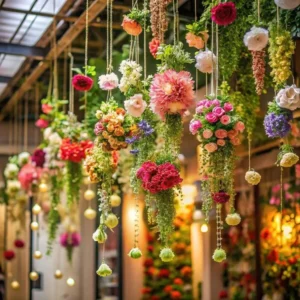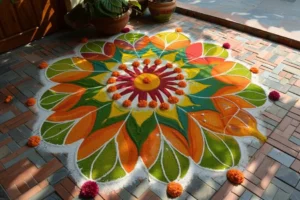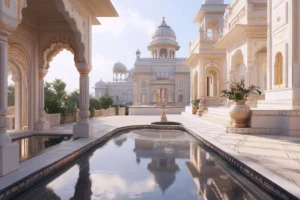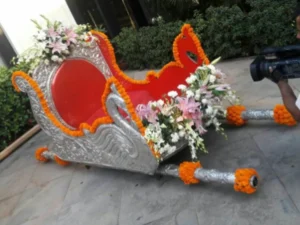South India is known for its beautiful traditions and customs, especially during weddings. Among all the things that make a South Indian wedding special, the way the bride dresses is something truly captivating. In this article, we will explore the hidden meanings behind the beautiful way South Indian bridal drapes their sarees.
These sarees are not just pretty clothes; they are a way of telling stories, expressing love, and connecting to a rich cultural heritage. So, let’s dive into the world of South Indian bridal drapes and discover the special meanings behind each fold and color.
Significance Of Saree In South Indian Weddings
In South Indian weddings, the saree is a highly symbolic garment that represents grace, tradition, and heritage. It is a traditional wedding dress that reflects the region’s vast diversity. Every saree style has its own distinct charm, and the society and place in question frequently affect the choice of saree. Particularly popular in South Indian weddings, the ornate Kanjeevaram silk sarees, embellished with beautiful zari embroidery, symbolize prosperity and auspiciousness.
The South Indian wedding saree adds to the joyful mood of the occasion with its vivid colors, intricate embroidery, and traditional motifs. Beyond only being aesthetically pleasing, the saree in South Indian weddings serves as a potent cultural emblem, uniting generations and fusing the past and present to create an enduring and beloved custom.
South Indian Draping Styles
Madisar And Koorai:
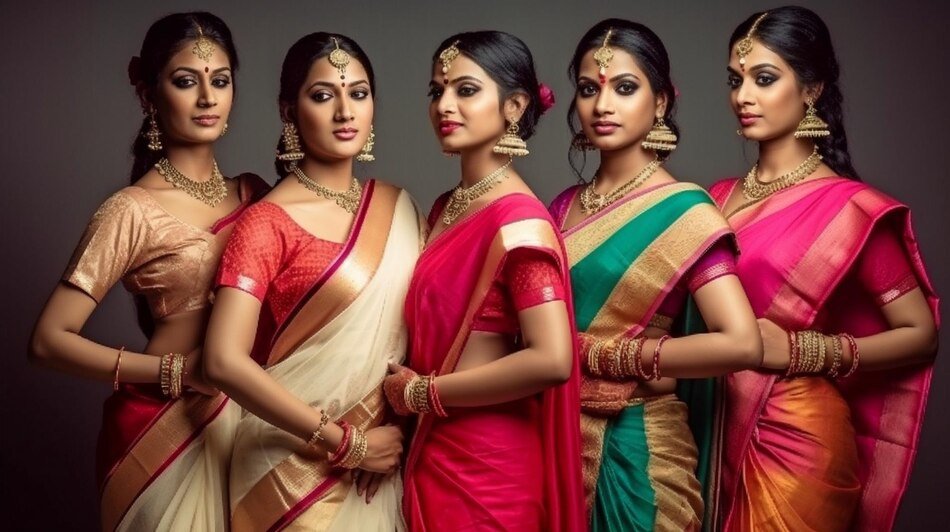
In Tamil Nadu, the Madisar and Koorai draping styles are popular among married women. Madisar involves wrapping the saree in a particular way, with a distinctive pleating pattern, while Koorai is the traditional red and white saree worn by brides.
Nivi Style:

Although commonly associated with North India, the Nivi style has made its way into South Indian wardrobes. It involves pleating a saree at the waist and allowing the pallu (decorative end) to fall gracefully over the shoulder.
Seedha Pallu:
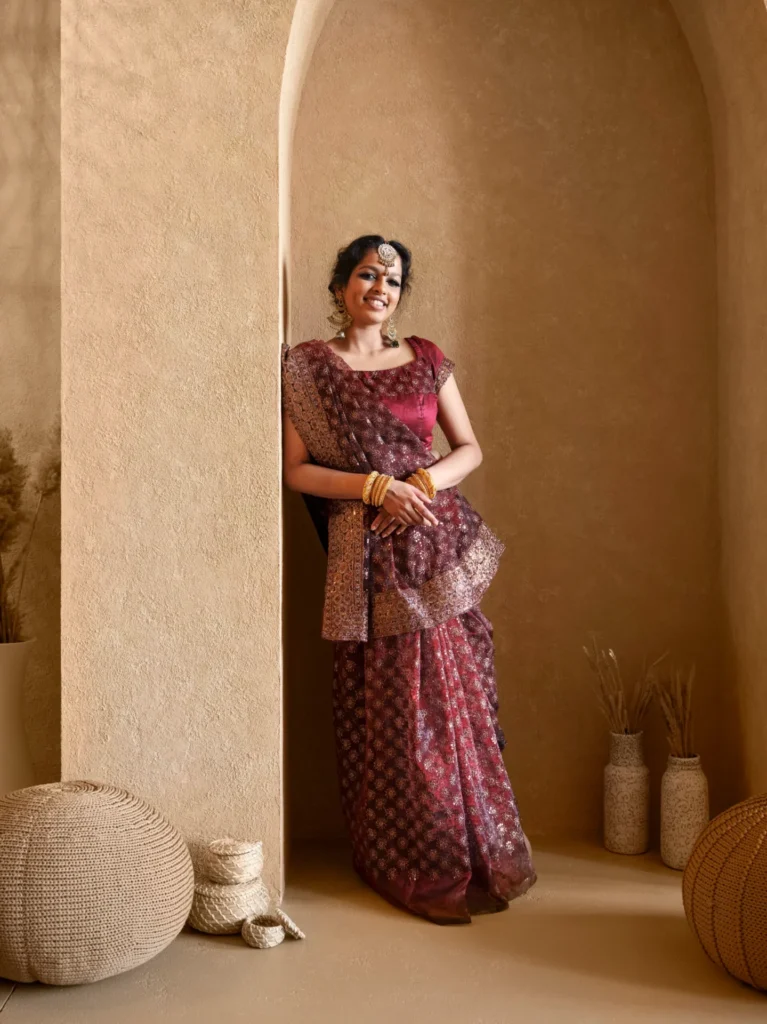
This draping style is prevalent in Andhra Pradesh and involves bringing the pallu from the back over the right shoulder, allowing for easy movement and an elegant look.
Gadwal Saree Draping:
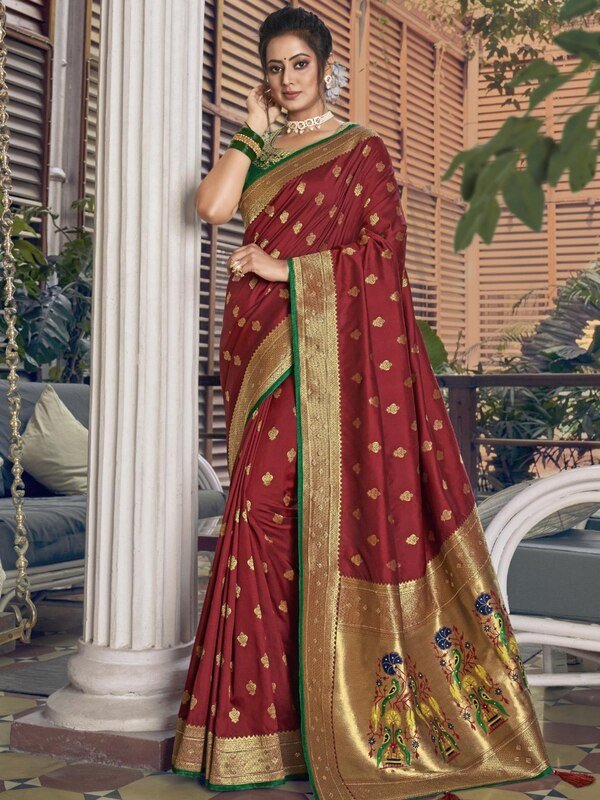
The Gadwal saree from Telangana has a distinct draping style. The saree is worn in a way that showcases both the silk and cotton portions, creating a unique and appealing visual effect.
Mundum Neryathum:
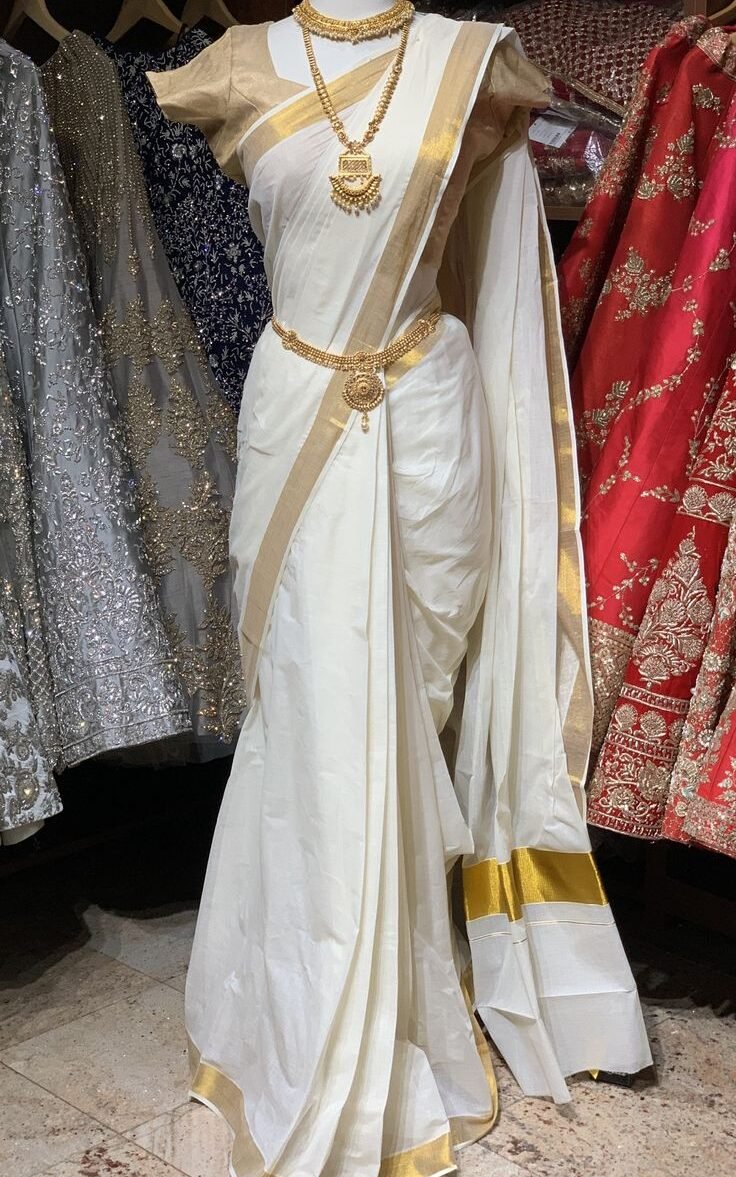
This is the traditional two-piece attire worn by women in Kerala. It consists of a mundu (lower garment) and neriyathu (upper garment). The mundu is draped in a way that showcases the golden border, and the neriyathu is elegantly pleated and worn over the blouse.
Gajra Style:
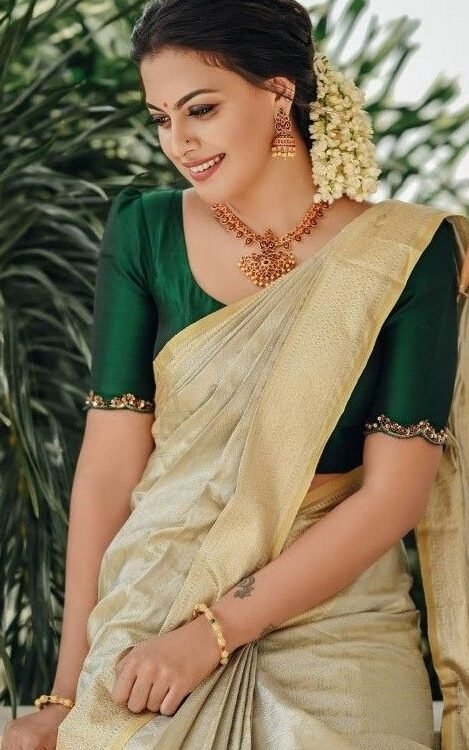
In Karnataka, the Gajra draping style is popular, where the saree is draped in a manner that resembles the pleats of a Gajra (flower garland), creating a distinctive and eye-catching appearance.
The Beauty Of Embroidery On Drapes
Embroidery on drapes makes them look really beautiful. It’s like adding special artwork to plain fabrics, making them fancy and charming. Whether it’s the pretty patterns on a traditional saree or the detailed designs on curtains, embroidery brings out the best in drapes. People in different places use embroidery to tell stories and show off their cultural heritage. Skilled hands create these lovely designs, turning simple fabric into something special and unique.
What’s cool about embroidery is that it captures the spirit of different cultures. You can find all sorts of designs – from colorful flowers to interesting shapes – that reflect the traditions and skills of the people who make them. So, whether it’s a bride’s saree in South India or the curtains in someone’s home, embroidered drapes not only look great but also carry the history of art and craft, connecting today with the cool traditions of the past.
Rituals And Symbolism During The Saree Draping Ceremony
Blessings And Auspicious Beginnings:
Saree draping ceremonies in South India often start with blessings for the person wearing the saree. Elders or family members wish for a happy and prosperous life as the ceremony marks a significant and auspicious beginning.
Symbolic Tying Of The Knot:
The act of tying the saree is symbolic of the marital knot, representing the commitment and union in a person’s life. It signifies the journey into a new phase, such as marriage, and the responsibilities that come with it.
Family Involvement:
The ceremony is a family affair, involving close relatives and friends. This emphasizes the importance of family bonds and the support system that surrounds the person entering a new chapter in their life.
Traditional Chants And Ritual Songs:
During the saree draping ceremony, traditional chants or ritual songs are often recited. These sacred verses carry cultural and religious significance, infusing the event with a spiritual atmosphere.
Exchange Of Gifts:
It is customary for gifts to be exchanged during the ceremony, symbolizing love and goodwill. The gifts may include traditional jewelry, clothes, or items with cultural significance, representing the family’s blessings for a prosperous future.
Respecting Ancestral Customs:
The ceremony follows age-old customs, respecting the cultural heritage of South India. Each step in the saree draping process holds symbolic meaning, and adherence to these customs connects the individual to their roots and traditions.
Bridal accessories that go well with drapes
Venis/Gajra
The Venis or Gajra is a lovely accessory worn by South Indian brides. It’s a string of fresh flowers, often jasmine, carefully arranged into a beautiful garland. Brides wear it in their hair, adding a fragrant and pretty touch to their look. The sweet scent of the flowers and the vibrant colors make the Venis or Gajra a charming symbol of beauty and tradition in South Indian weddings.
Floral Meli Musugu
The Floral Meli Musugu is a charming hair accessory worn by South Indian brides. It typically consists of a cluster of small flowers intricately arranged and attached to the bride’s hair. This floral adornment adds a touch of grace and natural beauty to the bride’s hairstyle, complementing the overall bridal look. The Floral Meli Musugu is a delightful and traditional accessory that enhances the bride’s appearance with the freshness and fragrance of flowers.
Wedding Garlands
Wedding Garlands are an essential part of South Indian wedding ceremonies. These garlands, made of fresh flowers, are exchanged between the bride and groom as a symbol of their love and commitment. The vibrant colors and the fragrance of the flowers represent the freshness and beauty of their marital journey.
Pelli Poola Jada
Pelli Poola Jada is a traditional hair accessory worn by South Indian brides. It consists of a long braid decorated with flowers, gold ornaments, and sometimes even pearls. This elaborate hair arrangement not only enhances the bride’s beauty but also carries cultural significance, symbolizing prosperity and happiness in her married life.
Conclusion
In conclusion, it’s not just about looking beautiful on the wedding day; it’s about connecting with traditions that go way back. The bridal saree is not just a piece of clothing; it’s a way to celebrate where you come from, show love, and keep the spirit of tradition alive. As we understand these meanings and the rich culture behind South Indian bridal drapes, we find that it’s not just about clothes; it’s a beautiful way of celebrating heritage and love.
FAQ
Why is the passing down of bridal sarees considered significant in South Indian families?
Bridal sarees often become family heirlooms, carrying not just fabric but the emotions and memories of previous generations. Wearing a saree and wedding accessories passed down from a mother or grandmother signifies the continuity of tradition and familial connections.
How have South Indian bridal drapes evolved in contemporary times?
In modern times, brides seek a balance between traditional aesthetics and contemporary styles. Designers experiment with colors, fabrics, and draping techniques, creating fusion ensembles that reflect the bride’s individuality while honoring cultural traditions.
What is the significance of the color red in South Indian bridal drapes?
Red is considered the most auspicious color, symbolizing love, passion, and fertility. It holds a special place in South Indian weddings, representing the bride’s commitment and the beginning of a new life.


